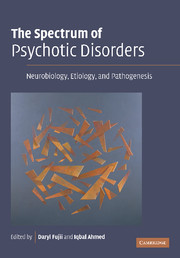Book contents
- Frontmatter
- Contents
- List of Contributors
- Preface
- Acknowledgements
- Part I Introduction
- Part II Primary Psychotic Disorders
- Part III Mood Disorders
- Part IV Neurodevelopmental and Genetic Disorders
- Part V Central Nervous System Disorders
- Part VI Substance Abuse and Medications
- Part VII Neurodegenerative Disorders
- Part VIII Sensory Impairments
- Part IX Conclusion
- 27 Conclusion
- Index
- References
27 - Conclusion
from Part IX - Conclusion
Published online by Cambridge University Press: 06 January 2010
- Frontmatter
- Contents
- List of Contributors
- Preface
- Acknowledgements
- Part I Introduction
- Part II Primary Psychotic Disorders
- Part III Mood Disorders
- Part IV Neurodevelopmental and Genetic Disorders
- Part V Central Nervous System Disorders
- Part VI Substance Abuse and Medications
- Part VII Neurodegenerative Disorders
- Part VIII Sensory Impairments
- Part IX Conclusion
- 27 Conclusion
- Index
- References
Summary
Introduction
In this chapter we integrate the information on the spectrum of psychotic disorders. First, we summarize data from each of the nine sections. Second, we examine whether the collective data supports our neurobiological hypothesis of psychosis. Next, we utilize the collective data to update our conceptual framework for developing a psychosis. Fourth, implications for DSM-IV diagnostic criteria for psychosis are discussed. Fifth, we report limitations of the data as it relates to psychosis as a neurobiological syndrome. We conclude the chapter and the book by proposing future studies to further elucidate the phenomenon of psychosis. To promote clarity and avoid redundancy, material cited by chapter authors will not be referenced. Instead, readers are encouraged to refer to each chapter for specific citations.
Epidemiology
The epidemiology of psychotic disorders associated with different etiologies is wide ranged, varying from less than 1% of the overall population for acute and transient psychosis, to up to 84% of patients with Lewy body dementia. Prevalence rates appear to be related to the type of disorder and its neurobiology, although variability exists within each group of disorders.
The group with the smallest prevalence rate, around 1% of the general population, is comprised of “primary” psychotic disorders including schizophrenia, schizoaffective disorder (SAD), delusional disorder (DD), and brief psychotic disorder (BPD).
Neurological disorders that are commonly associated with temporal lobe pathology or white matter lesions have estimated prevalence rates of psychosis ranging from 1–15%.
- Type
- Chapter
- Information
- The Spectrum of Psychotic DisordersNeurobiology, Etiology and Pathogenesis, pp. 535 - 556Publisher: Cambridge University PressPrint publication year: 2007



